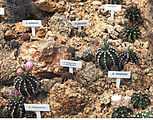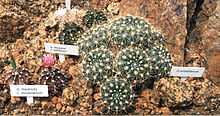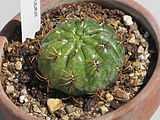Gymnocalycium
| Gymnocalycium | |
|---|---|
 | |
| Gymnocalycium baldianium | |
| Scientific classification | |
| Kingdom: | Plantae |
| (unranked): | Angiosperms |
| (unranked): | Eudicots |
| (unranked): | Core eudicots |
| Order: | Caryophyllales |
| Family: | Cactaceae |
| Subfamily: | Cactoideae |
| Tribe: | Trichocereeae |
| Genus: | Gymnocalycium Pfeiff. ex Mittler |
| Species | |
|
About 70, including: | |
| Synonyms | |
|
Brachycalycium Backeb. | |
Gymnocalycium, commonly called chin cactus, is a genus of about 70 South American species of cacti. The genus name Gymnocalycium (from Greek, "naked calyx") refers to the flower buds bearing no hair or spines.
Their main area of distribution is Argentina, part of Uruguay, Paraguay, southern Bolivia and part of Brazil. Most species are rather small varying from 4 to 15 centimetres in size. In cultivation they are popular for their easy flowering habits, and the flowers are generally brightly coloured. Where temperatures fall below 10 °C (50 °F) they must be cultivated under glass with heat.[1]
References
-

Gymnocalycium species from Liberec botanical garden
-

Gymnocalycium species from Liberec botanical garden
-

Gymnocalycium species from Liberec botanical garden
-
Gymnocalycium mihanovichii in flower
-
The flower of Gymnocalycium horstii
-
Gymnocalycium baldianum in flower
-
The Ruby Ball or Moon Cactus, Gymnocalycium mihanovichii 'Hibotan', is a mutant that lacks chlorophyll
External links
| Wikimedia Commons has media related to Gymnocalycium. |
| Wikispecies has information related to: Gymnocalycium |








